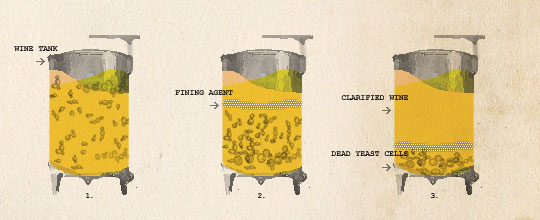If you visit as many wineries as I do (no judgment!), you probably hear the terms fining and filtration thrown around a lot. People tend to discuss their place in the winemaking process and the effects they have on the wine themselves. Some folks contend that fining and/or filtering wine strips them of color, aroma, nuance and complexity. And they are probably right, but I’ll leave that for another time.
For now, I just wanted to discuss what each of these terms means and how they are accomplished in winemaking so that you’ll know what’s going on next time they come up in conversation.

Fining is when you add something to the wine to clarify it. Photo credit: Star Chefs.
Fining
Fining means…well, to make a wine more fine. Specifically, winemakers add an agent like egg whites, bone marrow, gelatin or a sort of clay composite to a young wine.
This agent acts sort of like a magnet with iron filings, pulling unwanted particles and elements like tartrates (these little crystals that can sometimes form in the wine), proteins and other components that can make a wine cloudy or affect its taste adversely, and clarifies the color. The winemaker lets the agent float down through the wine, where it binds to these large particles and precipitates them out of the wine. The winemaker can then syphon those particles off, leaving the clearer liquid behind.
That Sauvignon Blanc you’re sipping? You can see through its bright yellow sunniness because it’s been fined.
Unfortunately for pure vegans, most fining agents tend to be derived from animal byproducts. My favorite is isinglass, which is a collagen derived from dried fish bladders. Lovely. Go ahead and throw that into your next dinner party conversation.
So that’s fining. Now on to…
Filtration
This is sort of like fining in that filtering a wine can clarify its color and pull particles out of the wine. However, whereas fining wine involves putting something into the wine to bind to those big, undesirable particles and precipitate them out of the liquid, filtration occurs when you pass the wine through a filter, or a series of filters.

Instead of adding something to wine, filtration is when you pass it through something to pull particles out. Image courtesy of 3M.
Like fining, filtration occurs after fermentation when the wine is already made and has usually been sitting around for a while. The winemaker can run it through any number of things like cellulose or clay filters to get any big particles out, and then even microfilter it to remove any yeast or harmful bacteria prior to bottling.
So that’s the difference for you. Fining is adding something to the wine to pull things out and filtration is passing the wine through something to pull things (often the same things) out. All to achieve a clearer glass of wine to you.
As I mentioned, there tends to be a lot of debate about just what fining and filtration does to the character of wines and I’ll have some interviews in the future with winemakers on both sides of the discussion, so stay tuned. In the meantime, feel free to tweet me @ClusterCrush with any questions!

